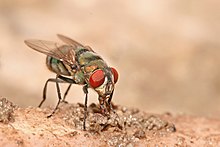
Chrysomya putoria

| Chrysomya putoria | |
|---|---|

| |
| Member of genus Chrysomya (Old World blow fly) on a leaf | |
| Scientific classification | |
| Domain: | Eukaryota |
| Kingdom: | Animalia |
| Phylum: | Arthropoda |
| Class: | Insecta |
| Order: | Diptera |
| Family: | Calliphoridae |
| Genus: | Chrysomya |
| Species: | C. putoria
|
| Binomial name | |
| Chrysomya putoria (Wiedemann, 1830)
| |
Chrysomya putoria, also known as the tropical African latrine blowfly, is a fly species belonging to the blowfly family, Calliphoridae. C. putoria is native to Africa and has recently spread to the Americas.[1] These flies pose significant health risks, especially due to their close association with human settlements.[1] Adult flies can carry pathogens, while larvae may cause myiasis by growing and feeding on the flesh of domestic animals and humans.[2] Other myiasis-causing flies in the same genus are C. bezziana and C. megacephala. C. putoria and other flies that feed on decomposing tissue are used as important tools in forensic entomology to establish the post-mortem interval, or the time elapsed since death.[2]

Description
The adult body is 8–10 mm (0.31–0.39 in) long, slightly larger than the average housefly, and metallic green, with an occasional tinge of metallic dark blue or bronze.[3] The face of C. putoria is generally dark in color.[4] Their wings are translucent, and the posterior edge of the abdomen is striped with black bands.[3] While both sexes have black frons, the female has a much broader frons located between its widely-spaced eyes.[3] This species has easily visible dusting on the upper side of its thorax, allowing it to be distinguished from many other closely related Calliphoridae species.[5]

Habitat and distribution

C. putoria originates from the tropics of the Old World, specifically Africa.[1] The fly is widely distributed across the central and southern regions of the African continent, and found in countries including Zambia, Ethiopia, and Madagascar.[6] Within the past few decades, several Chrysomya species, including C. putoria, invaded South America.[1] These flies may have been initially introduced into Brazil from Africa in the 1970s before spreading across the rest of the continent.[7] This dispersal may be connected to human mobility through the use of transportation like airplanes and ships.[1] C. putoria is now found in many South American countries, including Argentina, Brazil, Colombia, Paraguay, and Peru.[1] This spread of wild fly species may have also been facilitated by the fly's strong flying skills and synanthropy, known as the ability to benefit by closely associating with human habitats.[1] As a tropical species, C. putoria prefers to inhabit warmer climates. In its native Old World habitat, this fly is generally found in areas with a temperature above 26.7 °C.[1]

Taxonomy
Members of the family Calliphoridae lay larvae in the tissue and feces of warm-blooded animals, such as in pit latrines.[8]

The African blowfly C. chloropyga is the sister species of C. putoria and also breeds on feces and decaying flesh.[9][10] Due to morphological similarities, these flies were previously considered to be subspecies.[11] Phylogenetic analysis of cytochrome c oxidase gene sequences indicates that the two species diverged just a few thousand years ago.[9]


C. albiceps and C. putoria both spread to the Peruvian Andes by 1980.[1] While they broadly overlap at the elevation of 1,000 m (3,300 ft), their distributions indicate differential temperature preferences.[1] C. putoria prefers inhabiting warmer, tropical areas below 1,000 m (3,300 ft), while C. albiceps can typically be found in temperate areas between 1,000 and 3,100 m (3,300 and 10,200 ft).[1]

Life history
Egg
C. putoria eggs are approximately 1.5 mm (0.06 in) long, rod-shaped, and cream-white in color.[3]

Larva
C. putoria undergoes three larval instar stages.[3] After hatching from the egg, the larva in the first instar is 3–4 mm (0.12–0.16 in) long with 11 spine bands aligned along its 12 separate body segments.[3] In addition, a pair of spiracles can be seen on its most posterior segment with a singular spiracular opening.[3][12] During the second instar, the larva remains cream-white in color and grows to 6–10 mm (0.24–0.39 in) in length.[3] It develops fleshy folds and a pair of spiracles along its 2nd segment.[3] The posterior spiracles now present two spiracular openings.[12] The maxillary palp and antennae are also more developed.[12] In the final instar stage, the larva reaches a length of 13 mm (0.51 in) and develops larger fleshy folds.[3] The posterior spiracles are then fully developed with three spiracular openings.[12] The spine on the anal segment has a bell-shaped appearance.[13]

Pupa
The pupal stage lasts approximately 5 days.[14] Early on, the malleable outer layer of the final instar becomes brittle and hard.[14] The surface of the pupa is rough, bumpy, and unreflective.[2] At the same time, the translucent cuticle gains creamy-white pigmentation.[14] The body transforms on the second day, taking on yellow pigmentation and increasing the size of the head and wings.[14] On the third day, the eyes turn orange and the body pigmentation shows a reddish tinge with a black stripe across the abdomen.[14] On the fourth day, three black stripes appear across the abdomen, the wings, the legs become black, and the eyes and body darken into a brown color.[14] On the fifth and final day, the body turns black, and the fly ecloses by breaking through the pupal casing.[14]

Adult
The adult female has approximately 80 ovarioles in each of her two ovaries.[15] She also has a pair of tubular sexual accessory glands that lead into the common oviduct.[16] In addition, the female has three spherical spermathecae that store sperm from males after mating.[15]

Food resources
Adult C. putoria females lay eggs on feces, decaying flesh, and rotting food matter.[16] As a result, the larvae feed and grow on these substrates.[16]

If there is a scarcity of resources, C. putoria larvae may cannibalize one another after 24 hours.[17] In addition, injured larvae leak hemolymph, which may induce cannibalistic tendencies in other larvae.[17]

Social behavior
Similar to other blowfly species, C. putoria exhibit larval gregariousness.[18] The aggregation of larvae in isolated, temporal patches of food demonstrates intraspecific and interspecific competition.[18]

Predators and pathogens
Podisus nigrispinus, a species of stinkbug, is a predator of C. putoria larvae.[19] The larvae of C. albiceps, another member of the blowfly family, are facultative predators of C. putoria larvae and the larvae of other fly species.[20] C. albiceps larvae will surround then fatally pierce the target.[20]

C. putoria are affected by pathogenic fungi Metarhizium anisopliae and Beauveria bassiana that act as parasitoids and can eventually kill.[21]

Genetics
The diploid chromosome number is 2n = 12, and all the chromosomal pairs are metacentric.[22] Their count consists of 5 autosomal pairs and a sex chromosomal pair with an XY sex-determination system.[22] Karyotype analysis indicates that the pericentromeric region of the autosomal chromosomes includes a C band, while the 3rd pair of chromosomes additionally includes an interstitial band.[22]

Physiology
Studies on the effect of temperature changes on the development of these flies found that the optimal temperature for egg survivability is between 20 and 30 °C (68 and 86 °F), consistent with the flies' preference for tropical climates.[23] C. putoria has a developmental threshold of ~13.42 °C (56.16 °F), which is relatively higher than C. chloropyga's threshold of ~10.91 °C (51.64 °F), supporting their differential adaptations to temperature.[10]

Interactions with humans

Medical significance
The synanthropy of these flies is especially concerning, as their preference for human settlements may contribute to a major health impact in developing countries.[1] Since these flies often breed in latrines, they are especially dangerous pests in areas with low sanitation.[24] The effect of these flies is further compounded by their high population density and capability of widespread dispersal.[12][14] Breeding in the feces of domestic animals, especially poultry, can spread pathogens to humans.[16][24] Furthermore, their attraction to breeding on human and dog feces can make them vectors of diarrheal pathogens.[25] This is supported by PCR analysis showing C. putoria flies infected with E. coli, Salmonella, and Shigella. Myiasis can also occur if an adult female lays eggs inside the body of a living animal.[2]

While chemical insecticides are commonly used to control synanthropic fly populations, there are potential adverse side-effects of these chemicals on the health of humans, animals, crops, and the environment.[26] Efforts to target latrines may be effective at reducing the impact of these pests, since latrines are a major source of fly populations.[27]

Chrysomya putoria larvae have potential use in maggot therapy since their removal of dead tissue in wounds can promote the growth of new tissue.[28]

Forensic importance
Since the larvae of C. putoria and other blowfly species actively decompose cadavers, understanding their life cycle duration can be used to estimate the PMI (post-mortem interval).[29] Cocaine and other drugs in the cadaver's system can accelerate the life cycle of the larvae, therefore introducing error into PMI analysis.[30] Ongoing studies on the impact of drugs on the life cycle duration can reduce potential sources of PMI estimation errors.[30]

References
- ^ a b c d e f g h i j k l Baumgartner D, Greenberg B (26 January 1984). "The Genus Chrysomya (Diptera: Calliphoridae) in the New World". Journal of Medical Entomology. 21: 105–113. doi:10.1093/jmedent/21.1.105.
- ^ a b c d Amorim JA, Ribeiro OB (August 2001). "Distinction among the puparia of three blowfly species (Diptera: Calliphoridae) frequently found on unburied corpses". Memórias do Instituto Oswaldo Cruz. 96 (6): 781–4. doi:10.1590/s0074-02762001000600007. PMID 11562702.
- ^ a b c d e f g h i j Abdalla SB, Mohamed EA (5 November 2015). "Morphological and taxonomical characteristics of Chrysomya putoria (Diptera: Caliphoridae". Sudan Journal of Science. 6 (1). ISSN 1858-5795. Archived from the original on 26 October 2019. Retrieved 26 October 2019.
- ^ Lutz L, Williams KA, Villet MH, Ekanem M, Szpila K (May 2018). "Species identification of adult African blowflies (Diptera: Calliphoridae) of forensic importance". International Journal of Legal Medicine. 132 (3): 831–842. doi:10.1007/s00414-017-1654-y. PMC 5919996. PMID 28849264.
- ^ Bharti, Meenakshi (26 January 2019). "New records of Chrysomya putoria and C. thanomthini (Diptera: Calliphoridae) from India, with a revised key to the known Indian species". Journal of Threatened Taxa. 11 (1): 13188–13190. doi:10.11609/jott.4470.11.1.13188-13190. ISSN 0974-7907.
- ^ Irish S, Lindsay T, Wyatt N (July 2014). "Key to Adults of Afrotropical Species of the Genus Chrysomya Robineau-Desvoidy (Diptera: Calliphoridae)". African Entomology. 22 (2): 297–306. doi:10.4001/003.022.0210. S2CID 86184922.
- ^ Guimarães JH, do Prado AP, Buralli GM (1979). "Dispersal and distribution of three newly introduced species of Chrysomya Robineau-Desvoidy in Brazil (Diptera, Calliphoridae)". Revista brasileira de entomologia. ISSN 0085-5626.
- ^ Amendt J (6 January 2010). Current Concepts in Forensic Entomology. Springer. pp. 174–. ISBN 978-1-4020-9684-6. Retrieved 31 July 2013.
- ^ a b Wells JD, Lunt N, Villet MH (December 2004). "Recent African derivation of Chrysomya putoria from C. chloropyga and mitochondrial DNA paraphyly of cytochrome oxidase subunit one in blowflies of forensic importance". Medical and Veterinary Entomology. 18 (4): 445–8. doi:10.1111/j.0269-283X.2004.00531.x. PMID 15642013. S2CID 7653605.
- ^ a b Richards CS, Crous KL, Villet MH (March 2009). "Models of development for blowfly sister species Chrysomya chloropyga and Chrysomya putoria". Medical and Veterinary Entomology. 23 (1): 56–61. doi:10.1111/j.1365-2915.2008.00767.x. PMID 19239614. S2CID 356182.
- ^ Parise-Maltempi PP, Avancini RM (April 2001). "C-banding and FISH in chromosomes of the blow flies Chrysomya megacephala and Chrysomya putoria (Diptera, Calliphoridae)". Memórias do Instituto Oswaldo Cruz. 96 (3): 371–7. doi:10.1590/s0074-02762001000300015. PMID 11313646.
- ^ a b c d e Mendonça PM, Dos Santos-Mallet JR, De Carvalho Queiroz MM (February 2012). "Ultrastructure of immature stages of the blowfly Chrysomya putoria (Wiedemann, 1818) (Diptera: Calliphoridae)". Microscopy Research and Technique. 75 (2): 206–11. doi:10.1002/jemt.21044. PMID 21761503. S2CID 5474361.
- ^ Greenberg B, Szyska ML (1 September 1984). "Immature Stages and Biology of Fifteen Species of Peruvian Calliphoridae (Diptera)". Annals of the Entomological Society of America. 77 (5): 488–517. doi:10.1093/aesa/77.5.488. ISSN 0013-8746.
- ^ a b c d e f g h Proença B, Ribeiro AC, Luz RT, Aguiar VM, Maia VC, Couri MS (September 2014). "Intrapuparial development of Chrysomya putoria (Diptera: Calliphoridae)". Journal of Medical Entomology. 51 (5): 908–14. doi:10.1603/ME13205. PMID 25276917. S2CID 32288074.
- ^ a b Avancini RM, do Prado AP (1 January 1986). "Oogenesis in Chrysomya putoria (Wiedemann) (Diptera : Calliphoridae)". International Journal of Insect Morphology and Embryology. 15 (5): 375–384. doi:10.1016/0020-7322(86)90031-0.
- ^ a b c d Tirone G, Avancini RM (1 January 1997). "Development of female accessory glands of Chrysomya putoria (Wiedemann) (Diptera: Calliphoridae) during oogenesis". International Journal of Insect Morphology and Embryology. 26 (1): 1–7. doi:10.1016/S0020-7322(96)00011-6. ISSN 0020-7322.
- ^ a b Botteon VW, Fernandes FS, Godoy WA (April 2016). "Induced Cannibalism in Experimental Populations of the Forensic Indicator Chrysomya putoria Wiedemann (Diptera: Calliphoridae)". Neotropical Entomology. 45 (2): 217–20. doi:10.1007/s13744-015-0354-x. PMID 26698866. S2CID 14885692.
- ^ a b Reis SD, Von Zuben CJ, Godoy WA (1999). "Larval aggregation and competition for food in experimental populations of Chrysomya putoria (Wied.) and Cochliomyia macellaria (F.) (Dipt., Calliphoridae)". Journal of Applied Entomology. 123 (8): 485–489. doi:10.1046/j.1439-0418.1999.00397.x. S2CID 84496295.
- ^ Botteon VW, Neves JA, Godoy WA (April 2017). "Functional Response and Matrix Population Model of Podisus nigrispinus (Dallas, 1851) (Hemiptera: Pentatomidae) fed on Chrysomya putoria (Wiedemann, 1818) (Diptera: Calliphoridae) as Alternative Prey". Neotropical Entomology. 46 (2): 137–143. doi:10.1007/s13744-016-0440-8. PMID 27604849. S2CID 22349374.
- ^ a b Faria LD, Orsi L, Trinca LA, Godoy WA (1999). "Larval predation by Chrysomya albiceps on Cochliomyia macellaria, Chrysomya megacephala and Chrysomya putoria". Entomologia Experimentalis et Applicata. 90 (2): 149–155. Bibcode:1999EEApp..90..149F. doi:10.1046/j.1570-7458.1999.00433.x. S2CID 56346606.
- ^ Caleffe, Ronaldo Roberto Tait; Oliveira, Stefany Rodrigues de; Schoffen, Rodrigo Pawloski; Junior, Verci Alves de Oliveira; Conte, Helio (2019). "Biological Control of Diptera Calliphoridae: A Review". Journal of the Entomological Research Society. 21 (2): 144–155.
- ^ a b c Parise-Maltempi PP, Avancini RM (April 2001). "C-banding and FISH in chromosomes of the blow flies Chrysomya megacephala and Chrysomya putoria (Diptera, Calliphoridae)". Memórias do Instituto Oswaldo Cruz. 96 (3): 371–7. doi:10.1590/s0074-02762001000300015. PMID 11313646.
- ^ Alonso MA, Souza CM, Linhares AX, Thyssen PJ (July 2015). "Egg Developmental Time and Survival of Chrysomya megacephala and Chrysomya putoria (Diptera: Calliphoridae) Under Different Temperatures". Journal of Medical Entomology. 52 (4): 551–6. doi:10.1093/jme/tjv066. PMID 26335461.
- ^ a b Greenberg B (May 1988). "Chrysomya megacephala (F.) (Diptera: Calliphoridae) collected in North America and notes on Chrysomya species present in the New World". Journal of Medical Entomology. 25 (3): 199–200. doi:10.1093/jmedent/25.3.199. PMID 3392717.
- ^ Lindsay SW, Lindsay TC, Duprez J, Hall MJ, Kwambana BA, Jawara M, et al. (1 November 2012). "Chrysomya putoria, a putative vector of diarrheal diseases". PLOS Neglected Tropical Diseases. 6 (11): e1895. doi:10.1371/journal.pntd.0001895. PMC 3486903. PMID 23133694.
- ^ Carriço C, Pinto ZT, Dutok CM, Caetano RL, Pessanha RR, Chil-Nuñez I, et al. (1 May 2014). "Biological activity of Pouteria sapota leaf extract on post-embryonic development of blowfly Chrysomya putoria (Wiedemann, 1818) (Calliphoridae)". Revista Brasileira de Farmacognosia. 24 (3): 304–308. doi:10.1016/j.bjp.2014.07.007. ISSN 0102-695X.
- ^ Lindsay TC, Jawara M, D'Alessandro U, Pinder M, Lindsay SW (February 2013). "Preliminary studies developing methods for the control of Chrysomya putoria, the African latrine fly, in pit latrines in The Gambia". Tropical Medicine & International Health. 18 (2): 159–65. doi:10.1111/tmi.12033. PMC 3596979. PMID 23198767.
- ^ Ferraz AC, Dallavecchia DL, da Silva DC, de Carvalho RP, da Silva Filho RG, Aguiar-Coelho VM (January 2014). "Evaluation of the influence of the antibiotic ciprofloxacin in the development of an Old World screwworm fly, Chrysomya putoria". Journal of Insect Science. 14: 3. doi:10.1093/jis/14.1.3. PMC 4199357. PMID 25373150.
- ^ Oliveira MS, Mello RP, Queiroz MM (2007). "Morphology and duration of larval instars of Chrysomya putoria (Wiedemann) (Diptera, Calliphoridae), in laboratory". Revista Brasileira de Entomologia. 51 (2): 239–245. doi:10.1590/S0085-56262007000200016.
- ^ a b de Carvalho LM, Linhares AX, Badan Palhares FA (July 2012). "The effect of cocaine on the development rate of immatures and adults of Chrysomya albiceps and Chrysomya putoria (Diptera: Calliphoridae) and its importance to postmortem interval estimate". Forensic Science International. 220 (1–3): 27–32. doi:10.1016/j.forsciint.2012.01.023. PMID 22341241.
See what we do next...
OR
By submitting your email or phone number, you're giving mschf permission to send you email and/or recurring marketing texts. Data rates may apply. Text stop to cancel, help for help.
Success: You're subscribed now !
